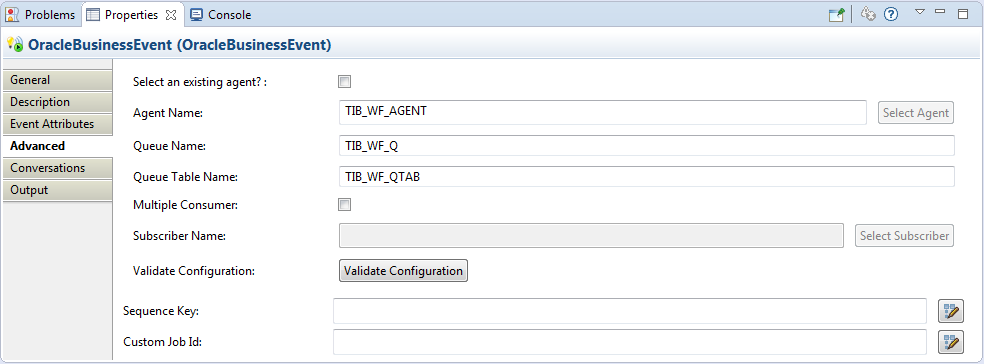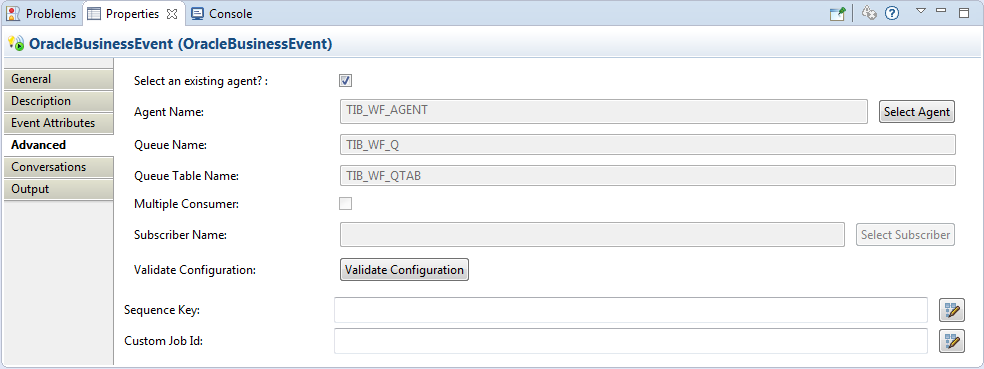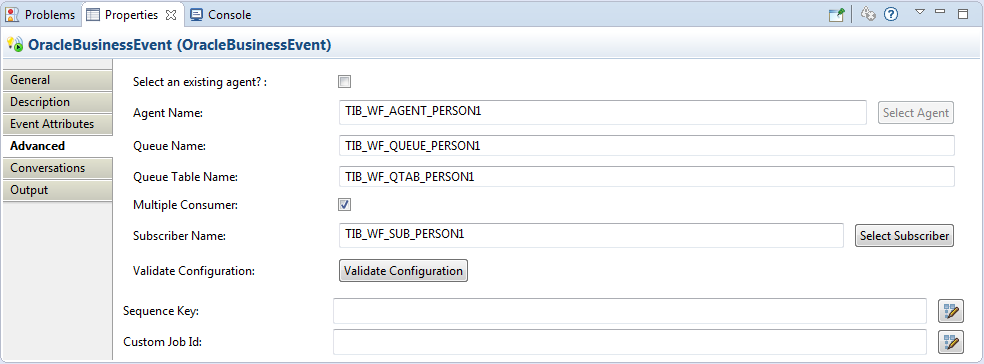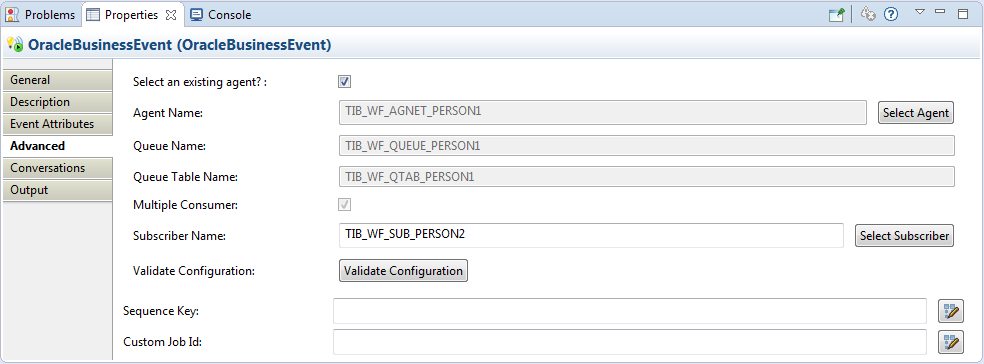Oracle Business Event
You can use the Oracle Business Event activity to listen for an Oracle Business Event triggered in the Oracle E-Business Suite application.
When the Oracle Business Event is triggered, the Oracle Business Event activity pulls the event data from the Oracle event queue, and makes the data available to TIBCO environment. Custom business events configured in Oracle E-Business Suite and registered into Oracle Integration Repository are compatible with this activity.
A business event represents an action or occurrence triggered by a business process in an application or system. This event might be significant to other programs, applications, processes, or external agents. In Oracle E-Business Suite, events can be triggered by business object manipulation such as an update or change, or by different processes such as the approval of a purchase order.
The Oracle Business Event activity provides the following functions:
General
In the General tab, you can establish a connection to an Oracle E-Business Suite server, and specify the event name.
The General tab contains the following fields:
| Field | Module Property? | Description |
|---|---|---|
| Name | No | The name of the resource.
The default is OracleBusinessEvent. |
| Shared Connection | Yes | A shared configuration resource containing the Oracle E-Business Suite connection information.
To select a shared connection resource, click the
Choose/Create Default Resource
|
| Event Name | No | The name of the Business Event. For example,
oracle.apps.per.api.person.update_person.
Click Search Event or the text field. Then, enter a part of the event name in the opened dialog or leave the text field empty, and click Search. Select an Oracle Business Event from the Oracle Business Event List dialog, and click OK. The Oracle Business Event List dialog lists two types of Business Events, Event and Group. Only the Event type Business Events are supported in this release. |
| Generate SQL Script | No | After configuring the Oracle Business Event activity, click
Generate SQL Script. The scripts to be generated are displayed in the opened dialog. Click
Generate, and the following two SQL scripts are created in the
TIBCO_HOME\bw\palettes\oracleebs\version_number\sql directory:
Run the ProcessName_ActivityName_EventName.sql script in the connected Oracle database before starting the process. The ProcessName_ActivityName_EventName.sql script creates the necessary infrastructure that makes the event available for use by the plug-in Oracle Business Event activity without having to manually configure this event in Oracle E-Business Suite. This involves the creation of a subscription, an agent, and the required linking of the Oracle business event to these entities. The script with the _undo suffix reverses the granted privileges and undoes the changes to the database. With this operation, you can cleanse the privileges for objects that are no longer used by obsolete or unwanted activities. |
Description
In the Description tab, you can enter a short description for the Oracle Business Event activity.
Event Attributes
In the Event Attributes tab, you can view the attributes of the Oracle Business Event.
Click Get Event Attributes. The attributes of the Business Event are parsed from XML format and displayed in this tab.
You can also click Delete Event Attributes to delete the event attributes. In this case, the event attributes in the Output tab are also removed.
Advanced
In the Advanced tab, you can specify the agent name, queue name, and queue table name, validate the configuration, and specify the sequence key and custom job ID. In addition, if multiple consumers are involved in the activity, you must specify the subscriber name.
The Advanced tab contains the following fields:
| Field | Module Property? | Description |
|---|---|---|
| Select an existing agent? | No | Select this check box to use an existing agent. If this check box is selected, the Agent Name, Queue Name, Queue Table Name, Multiple Consumer, and Subscriber Name fields are disabled, and the Select Agent button is applicable. |
| Agent Name | No | Enter a name for the agent that you intend to create to receive messages from Oracle Business Event System. |
| Queue Name | No | Enter a name for the queue to receive messages from the agent. |
| Queue Table Name | No | Enter a name for the queue table. |
| Multiple Consumer | No | Select this check box, if you want the messages to be consumed by multiple subscribers. In this case, the messages are propagated by using the topic method. Otherwise, the messages are propagated by using the queue method. |
| Subscriber Name | No | Enter the name of the subscriber who consumes the messages, or click Select Subscriber to select an existing subscriber. This field is applicable only when the Multiple Consumer check box is selected. |
| Validate Configuration | No | Validate the configuration of the Agent Name, Queue Name, and Queue Table Name fields. |
| Sequence Key | No | This field contains an XPath expression that specifies the order in which the process run. Process instances with sequencing keys that have the same value are executed sequentially in the order in which the process instances are created.
See the TIBCO ActiveMatrix BusinessWorks documentation for more information. |
| Custom Job Id | No | This field contains an XPath expression that specifies a custom job ID for the process instance. This ID is displayed in the
TIBCO Administrator View Service dialog, and it is also available in the
$_processContext process variable.
See the TIBCO ActiveMatrix BusinessWorks documentation for more information. |
When a Business Event is triggered in Oracle E-Business Suite, the plug-in listens to the event.
- If you want the event messages to be received by a single consumer, create a new set of agent, queue, and queue table for the subscription, or use an existing set of agent, queue, and queue table for the same Business Event.
-
To create a new set of agent, queue, and queue table, clear the Select an existing agent check box, and enter the names of the agent, queue, and queue table in their respective fields, as shown in the following figure. The agent, queue, and queue table are created in Oracle E-Business Suite after you run the generated SQL script.
-
To use an existing set of agent, queue, and queue table, select the Select an existing agent check box. In this case, the Agent Name, Queue Name, Queue Table Name, Multiple Consumer, and Subscriber Name fields are disabled, and the Select Agent button is applicable. Click Select Agent to select an existing agent for the subscription, and the related queue and queue table are obtained simultaneously, as shown in the following figure.
-
-
If you want the event messages to be received by multiple consumers, first, create a set of agent, queue, and queue table for the subscription of event messages; then specify the subscriber name.
-
To create a new set of agent, queue, and queue table for the subscription of event messages to be received by multiple consumers, clear the Select an existing agent check box, and specify the names of the agent, queue, and queue table in their respective fields. Select the Multiple Consumer check box, and specify the name of the subscriber that receives the event messages in the specific configuration, as shown in the following figure. The agent, queue, queue table, and subscriber are created in Oracle E-Business Suite after you run the generated SQL script.
-
To use this set of agent, queue, and queue table in other configurations, for example, in the following figure, select the Select an existing agent check box, and then select this agent. The related queue and queue table are obtained simultaneously; the Multiple Consumer check box is selected automatically and the Subscriber Name field is enabled. Specify the name of the subscriber. The subscriber is created in Oracle E-Business Suite after you run the generated SQL script. This subscriber can then receive messages from the same set of agent, queue, and queue table.
-

 icon. All usable connections are listed in the opened dialog. Select one to apply to your current activity. If no matching connection resource is found, click
icon. All usable connections are listed in the opened dialog. Select one to apply to your current activity. If no matching connection resource is found, click



